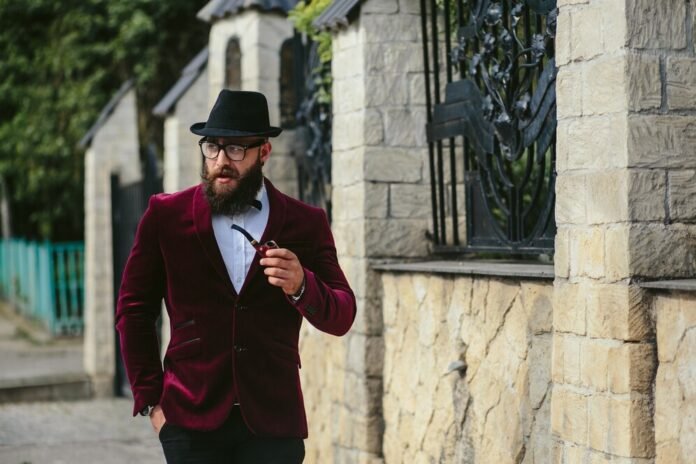The 1920s mens fashion was a transformative period in men’s fashion, marking a shift from the rigid Edwardian styles to a more relaxed, modern look. The era, often referred to as the “Roaring Twenties,” was characterized by economic prosperity, jazz culture, and evolving social norms, all of which influenced men’s clothing. From classic three-piece suits to the rise of sportswear and casual fashion, men in the 1920s embraced both sophistication and comfort in their attire. This article explores the key elements of 1920s men’s fashion, including suits, casualwear, footwear, and accessories, highlighting how they shaped modern menswear.
The Iconic 1920s Three-Piece Suit
Suits were the foundation of men’s fashion in the 1920s. The three-piece suit, consisting of a jacket, waistcoat (vest), and trousers, was the standard attire for formal and business settings. Unlike the previous decades, where suits were heavily structured and stiff, the 1920s introduced a more relaxed fit. Jackets had narrower lapels, natural shoulders, and were cut slightly shorter, while trousers became high-waisted and featured a looser fit to allow more movement.
Double-breasted suits also gained popularity, offering a more sophisticated look. Wealthier men often opted for suits made of fine wool, tweed, or even pinstripe patterns, while middle-class men wore simpler versions in muted colors like grey, brown, or navy. The influence of the Art Deco movement led to more bold patterns and creative fabric choices, making suits a blend of elegance and personal expression.
Casualwear and the Rise of Sports-Inspired Fashion
As social life became more dynamic, casualwear gained importance in men’s wardrobes. The rise of sports culture and outdoor activities in the 1920s led to a shift towards more relaxed and comfortable clothing. Knitted sweaters, cardigan jackets, and golf-style plus-fours (knickerbocker trousers that extended just below the knee) became widely accepted for casual occasions.
The popularity of golf, tennis, and automobile travel influenced the way men dressed. Sweater vests and polo shirts were often paired with pleated trousers for an effortless yet stylish appearance. Linen and cotton became the fabrics of choice for casualwear, allowing breathability and ease of movement. This period marked the beginning of a more practical approach to men’s fashion, where functionality and aesthetics worked hand in hand.
Formal Evening Wear: Tuxedos and Dinner Jackets
For formal events, men of the 1920s adhered to strict dress codes. Black-tie affairs required a tuxedo with a tailcoat or a dinner jacket, often paired with a crisp white dress shirt and a bow tie. The classic white pocket square and polished dress shoes completed the elegant ensemble.
A key distinction in evening wear was the presence of the white tie vs. black tie dress code. White tie events were the most formal, requiring a tailcoat, while black tie events allowed for a slightly more relaxed tuxedo style. Wealthy gentlemen often accessorized with cufflinks, pocket watches, and even top hats to enhance their appearance.
Hats and Accessories: The Finishing Touches
No 1920s outfit was complete without the right accessories, especially hats. The most popular hat styles included the fedora, homburg, and newsboy cap. The fedora was favored by businessmen and city dwellers, while the newsboy cap became a staple for working-class men. The boater hat, a flat-brimmed straw hat, was a stylish summer choice, often worn with light-colored suits.
Other essential accessories included silk ties, suspenders, and pocket squares. Leather gloves and walking canes were still in use, particularly among older gentlemen who adhered to traditional styles. Watches, particularly gold or silver pocket watches, were a symbol of sophistication, often attached to waistcoats with a chain.
Footwear Trends: Oxford Shoes and Two-Tone Spectators
Footwear in the 1920s mens fashion evolved to match the changing fashion landscape. The most common formal shoe was the Oxford, a sleek lace-up shoe made of high-quality leather. For a more casual yet stylish look, men often wore two-tone spectator shoes, which featured a bold contrast of black and white or brown and white.
The Influence of Hollywood and the Jazz Age on Men’s Fashion
One of the biggest influences on 1920s men’s fashion was Hollywood and the Jazz Age. Movie stars like Rudolph Valentino and Clark Gable set fashion trends, with men across the world emulating their suave, well-groomed looks. The Jazz Age, fueled by music and nightlife, encouraged bolder clothing choices, including pinstriped suits, silk shirts, and flashy accessories.
Gangster-inspired fashion also emerged during this time, thanks to figures like Al Capone. Wide lapels, double-breasted jackets, and fedoras became iconic, blending style with an air of rebellion.
Conclusion: A Legacy of Timeless Style
The 1920s was a pivotal decade for men’s fashion, laying the foundation for many modern trends. From tailored suits to relaxed casualwear, the decade struck a balance between sophistication and comfort. The emphasis on high-waisted trousers, stylish hats, and classic footwear continues to inspire contemporary menswear, proving that the elegance of the Roaring Twenties remains timeless. Whether it’s in movies, vintage-themed events, or modern fashion collections, the influence of 1920s men’s fashion is undeniable, cementing its place in history as one of the most stylish eras for men.


